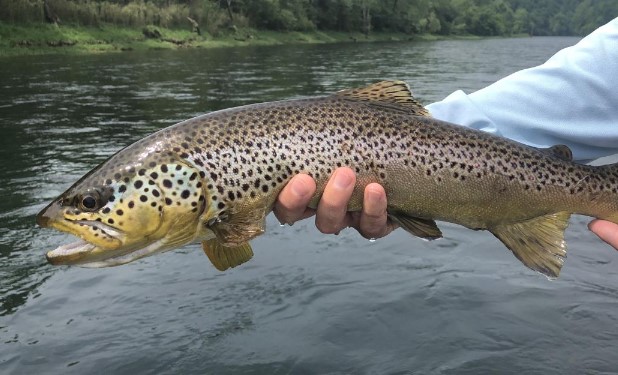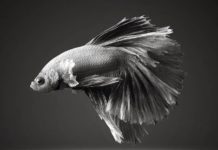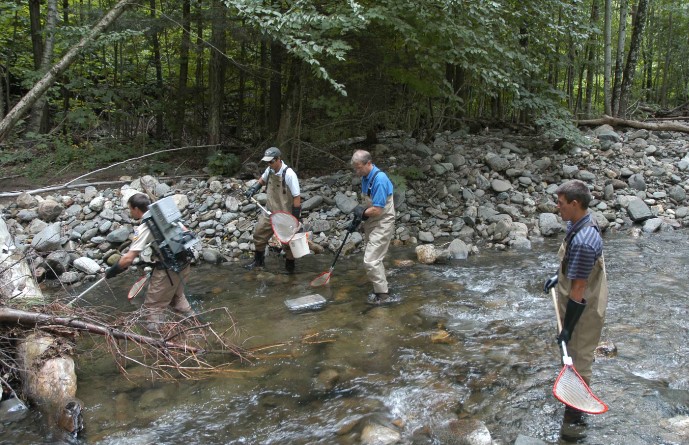Trout fishing in Arkansas can be a great experience, as the state offers many opportunities to catch rainbow, brown, and brook trout in its streams, rivers, and lakes. Trout can be found in many streams, rivers, and lakes in Arkansas, particularly in the Ozark and Ouachita Mountains. Some popular locations include the White River, Little Red River, and the Norfork River. Trout has a delicate, mild flavor with a slightly sweet and nutty taste. The flesh is tender and moist with a firm texture.
The taste of trout can vary depending on the species, the type of water in which it lives, and its diet. Some species of trout, such as rainbow trout and brook trout, have a mild, delicate flavor, while others, like lake trout, have a stronger, more robust flavor. Overall, trout is a popular and highly-regarded fish for its taste and versatility in cooking. You can also find trout in designated trout parks and hatcheries managed by the Arkansas Game and Fish Commission.

Some popular trout fishing destinations in Arkansas include:
-
The White River: This river is known for its abundant population of rainbow and brown trout, and offers excellent fishing opportunities throughout the year. The river is home to a healthy population of rainbow, brown, and brook trout, and provides a variety of fishing opportunities, from fast-moving streams to deep pools. Fishing techniques in the White River can include fly fishing, spin fishing, and bait fishing. Common lures for trout in the White River include dry flies, nymphs, and streamers for fly fishing, and spinners, spoons, and crankbaits for spin fishing. Live bait such as worms, minnows, and insects can also be effective. Fishing in the White River can be done from the bank or from a boat. A fishing license is required and can be obtained from the Arkansas Game and Fish Commission. The commission also regulates the minimum size limit and daily catch limit for trout in the White River, so be sure to familiarize yourself with these regulations before fishing. Overall, the White River in Arkansas offers a scenic and productive environment for trout fishing and is a great destination for anglers of all levels.
-
The Little Red River: This river is one of the best trout fisheries in the country, with a strong population of large rainbow trout. The Little Red River in Arkansas is known for its abundant and trophy-sized rainbow trout. The river is fed by the Greers Ferry Dam tailwaters, which provide a constant flow of cool water that creates ideal conditions for trout. The Little Red River is considered one of the top trout fishing destinations in the United States. Fishing techniques in the Little Red River can include fly fishing, spin fishing, and bait fishing. Fly fishermen often use nymphs, dry flies, and streamers, while spin fishermen use lures such as spinners, spoons, and crankbaits. Live bait such as worms, minnows, and insects can also be effective. Fishing in the Little Red River can be done from the bank or from a boat. A fishing license is required and can be obtained from the Arkansas Game and Fish Commission. The commission also regulates the minimum size limit and daily catch limit for trout in the Little Red River, so be sure to familiarize yourself with these regulations before fishing. Overall, the Little Red River in Arkansas offers a unique and challenging environment for trout fishing and is a must-visit destination for serious anglers.
-
The North Fork River: This river is another popular destination for trout fishing, with a healthy population of brown and rainbow trout. The river is home to rainbow, brown, and cutthroat trout, and is known for its clear and cold water. Fishing techniques in the North Fork River can include fly fishing, spin fishing, and bait fishing. Fly fishermen often use nymphs, dry flies, and streamers, while spin fishermen use lures such as spinners, spoons, and crankbaits. Live bait such as worms, minnows, and insects can also be effective. Fishing in the North Fork River can be done from the bank or from a boat. A fishing license is required and can be obtained from the Missouri Department of Conservation. The department also regulates the minimum size limit and daily catch limit for trout in the North Fork River, so be sure to familiarize yourself with these regulations before fishing. Overall, the North Fork River in Missouri provides a scenic and productive environment for trout fishing and is a great destination for anglers of all levels.
-
Bull Shoals Lake: This large reservoir is stocked with rainbow trout and offers fishing opportunities from shore or boat. Bull Shoals Lake in Arkansas and Missouri is a large and popular destination for trout fishing, offering a variety of fishing opportunities for anglers. The lake is home to rainbow, brown, and cutthroat trout, as well as other species such as bass and crappie. Fishing techniques in Bull Shoals Lake can include fly fishing, spin fishing, and bait fishing. Fly fishermen often use nymphs, dry flies, and streamers, while spin fishermen use lures such as spinners, spoons, and crankbaits. Live bait such as worms, minnows, and insects can also be effective. Fishing in Bull Shoals Lake can be done from the bank, from a boat, or from a float tube. A fishing license is required and can be obtained from the Arkansas Game and Fish Commission or the Missouri Department of Conservation, depending on where you are fishing. The commission also regulates the minimum size limit and daily catch limit for trout in Bull Shoals Lake, so be sure to familiarize yourself with these regulations before fishing. Overall, Bull Shoals Lake in Arkansas and Missouri provides a diverse and productive environment for trout fishing and is a great destination for anglers of all levels.
-
Norfork River – a scenic river, home to rainbow, brown, and cutthroat trout and is known for its clear and cold water. Fishing techniques in the Norfork River can include fly fishing, spin fishing, and bait fishing. Fly fishermen often use nymphs, dry flies, and streamers, while spin fishermen use lures such as spinners, spoons, and crankbaits. Live bait such as worms, minnows, and insects can also be effective. Fishing in the Norfork River can be done from the bank or from a boat. A fishing license is required and can be obtained from the Arkansas Game and Fish Commission. The commission also regulates the minimum size limit and daily catch limit for trout in the Norfork River, so be sure to familiarize yourself with these regulations before fishing. Overall, the Norfork River in Arkansas provides a scenic and productive environment for trout fishing and is a great destination for anglers of all levels.
-
Fayetteville, Arkansas is surrounded by some of the best trout fishing spots in the state. Beaver Lake is a popular destination for trout fishing, with its clear waters and abundant supply of rainbow and brown trout. War Eagle Creek is another top spot, known for its trophy-sized brown trout and scenic beauty. The White River, a tailwater fishery, is also a great option for trout fishing, with its plentiful rainbow, brown, and cutthroat trout. For those seeking a more remote experience, the Little Missouri River and Buffalo National River offer peaceful and serene environments for trout fishing. The Kings River, located near the Arkansas and Missouri border, is another top spot known for its trophy-sized brown trout and crystal clear waters. When fishing in the area, it’s important to check fishing regulations and obtain necessary permits, as well as to practice responsible and sustainable fishing techniques. With so many options available, trout fishing near Fayetteville, Arkansas is a must-do activity for any angler.
In Arkansas, trout fishing is regulated by the Arkansas Game and Fish Commission, which sets rules on the fishing season, daily limit, and minimum size requirements. Anglers should always check the local regulations and obtain a fishing license before heading out to fish for trout.
Trout is a species of freshwater fish in the salmonidae family, commonly found in cold-water streams and rivers in North America and Europe. They are prized for their delicate flavor and tender flesh and are often used in cuisine around the world. Some popular species of trout include rainbow trout, brown trout, and brook trout.
Trout fishing is a popular recreational activity that involves catching trout in rivers, lakes, and streams. The best season for trout fishing in Arkansas is typically from November to April. There are several methods for fishing for trout, including:
-
Fly fishing: This method uses a lightweight rod and reel, with a long and delicate line, to cast a small artificial fly that imitates insects or other prey.
-
Spin fishing: This method involves using a spinning rod and reel, with lures or baits such as spinners, crankbaits, or soft plastic lures, to imitate small prey.
-
Bait fishing: This method uses live bait or prepared baits such as worms, maggots, or PowerBait, to attract and hook the trout.
Regardless of the method, trout fishing requires an understanding of the trout’s habitat, behavior, and feeding patterns. Anglers should also be familiar with the local fishing regulations, such as fishing season, daily limit, and minimum size requirements.
To increase the chances of success, trout anglers often use specialized gear and equipment, such as waders or waterproof clothing, polarized sunglasses, and fish finders. They also pay attention to the weather, water conditions, and other environmental factors that can affect trout behavior. Trout fishing can be a challenging and rewarding activity, offering the opportunity to enjoy the beauty of nature and to catch a delicious and nutritious meal.
Equipment required to catch trout fish – The best times to catch trout in Arkansas are usually early in the morning and late in the evening. The following equipment is typically used to catch trout:
-
Fishing rod: A lightweight, medium-action spinning rod is a good choice for trout fishing.
-
Reel: A spinning reel with a good drag system is recommended.
-
Line: 4-6 lb monofilament or fluorocarbon line is suitable for trout fishing.
-
Lures or baits: Common lures for trout include spinners, spoons, and crankbaits. Live baits such as worms, minnows, and insects can also be effective.
-
Hooks: #8-12 hooks are suitable for trout fishing, with a specific size depending on the size of the bait used.
-
Sinkers: Split shot sinkers or other small weights can be used to sink the bait to the desired depth.
-
Fishing net: A landing net can be useful for safely landing and releasing the trout.
-
Tackle box: A small tackle box can be useful for carrying and organizing your fishing gear.
This is a basic list, and depending on the type of trout fishing you are doing (e.g. stream fishing, lake fishing, fly fishing), you may need additional equipment.
Trout fish for health – Trout is a healthy fish choice due to its high levels of omega-3 fatty acids, protein, vitamins, and minerals. It is important to note that trout can contain high levels of mercury, particularly if it is a larger, predatory species, so it should be consumed in moderation as part of a balanced diet.
Some of the health benefits of eating trout include:
-
Heart health: Omega-3 fatty acids in trout can reduce inflammation, lower blood pressure, and decrease the risk of heart disease.
-
Brain health: Omega-3 fatty acids also play a role in brain health and may improve cognitive function and reduce the risk of depression and Alzheimer’s disease.
-
Eye health: Trout is a good source of vitamin A, which is important for maintaining good vision.
-
Bone health: Trout is a good source of calcium, phosphorus, and vitamin D, which are all important for maintaining strong bones.
-
Weight management: Trout is a low-calorie, low-fat source of protein, making it a good choice for those trying to manage their weight.







